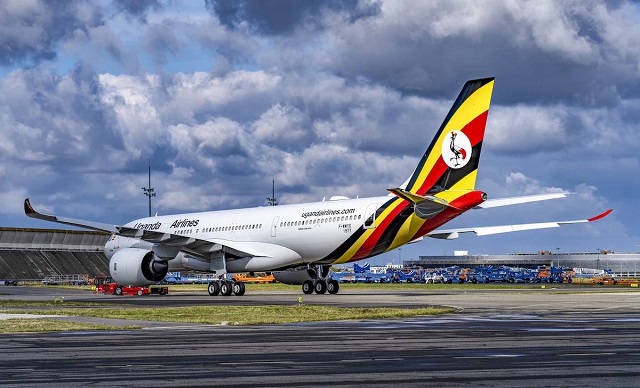
Kampala, Uganda | THE INDEPENDENT | Uganda Airlines, like many of its counterparts in the region will have to cater for two new challenges. That is, the ban on flights by destination markets as well as the plans by bigger and older airlines to re-dominate the market.
Less than three months after the launch of the Entebbe-Dubai flights, which was promising to be the most lucrative route, the flights were suspended, disrupting the growth plans by Uganda Airlines.
The October launch of the Uganda Airlines flight had come two months after the United Arab Emirates lifted a travel ban on several countries including Uganda in August, a ban that had been put in place in June, over a surge in new coronavirus infections then. Since then, Uganda Airlines has been operating between near to full capacity on the flights to Dubai, according to the acting Chief Executive, Jennifer Bamuturaki.
“On the first commercial flight, we had 80 passengers on our 258-passenger Airbus to Dubai. On the second flight, we had 220 passengers,” says Bamuturaki on the capacity of the Uganda Airlines. This has been the same picture on the shorter routes like Dar-es-Salaam and Johannesburg.
Thankfully, cargo between Uganda and the UAE will not be affected as only passenger flights have been suspended. And this business segment is playing a critical role in ensuring that the airlines remain in business, according to Bamuturaki.

“Definitely, business was affected by the ban. We were making 60,000 to 70,000 US Dollars per flight before the ban,” she says, adding that this was expected to grow with time. The carrier has been operating direct flight services between Entebbe and Dubai on a 258-seater Airbus A330-800 Neo three times a week, and the immediate plan was to increase these to five due to increasing demand.
On December 30, Kenya’s President Uhuru Kenyatta unveiled plans of a ‘Pan-African Airlines’ which would result from a merger of operations between Kenya Airways (KQ) and South African Airways (SAA).
Now, the December indefinite ban, whether or not it was expected by the Ugandan authorities and airlines managers, comes as a dent to its struggles to fit into the market.
But the CEO says all is not lost and they are catching up with business again through cargo. “We are now realizing an average of 50,000 to 60,000 US Dollars per flight. So you can see that it is playing out well,” she said, as the aircraft is now carrying more cargo without passengers than it was with passengers.
All hope is that should business normalize and the suspensions lifted, cargo will continue playing a major role and dedicated cargo flights could be introduced. While the Dubai route is mainly supported by the growing business between Uganda and the UAE, including the labour export market, Uganda Airlines has taken advantage of the grounding of SAA for almost two years now, to grow the Johannesburg route. For most of November and December, flights were usually fully booked.
SAA made the last flights in December 2020 when it was involved in repatriation operations for people returning home as the Covid19-induced lockdown continued to hamper international travel. But the company had ceased commercial scheduled flights in March the same year amidst financial crisis, which had seen employees lay down their tools for non-payment of salaries and wages.
Heavy government bailouts for the company have failed to revive it. Now, the company is tying up a deal with Kenya that is aimed at helping the two regain their regional market dominance. Addressing the nation in his New Year message on Friday, President Kenyatta said the national carrier signed a “Strategic Partnership Agreement” with South Africa, which was a major step towards jointly launching a Pan-African airline group by 2023.
“To boost tourism, trade, and social engagement; and to bolster continental integration, our national carrier Kenya Airways will join hands with our partners in South Africa to establish a Pan-African Airline,” he said. Like SAA, it has also not been well with Kenya Airways financially, despite the East African giant managing to remain in the sky to date.
The government of Kenya has shelved plans to re-nationalise the struggling company and instead opted to take over the debt that totals almost 1 billion dollars. Following a string of losses, plans were mooted for the government to take over all the shares of the company in 2019, however, the parliamentary procedure failed the plan.
The government owns 48.7 percent of the company, with another 38.1 percent owned by several banks through the KQ Lenders Company 2017 Ltd, followed by European flyer, KLM with 7.8 percent. The other shares are held by private owners through the stock markets in Uganda, Kenya and Tanzania.
In the last half of 2020/2021, the company posted a loss of 104 million dollars (370 billion Uganda shillings), but this was better than the performance in the same period in 2020 when the half-year loss hit 127 million dollars (451 billion Uganda shillings). This was due to an increase in cargo transport demand.
The company owed lenders 827 million dollars in debt, which the government has now decided to take over, according to the International Monetary Fund, instead of taking over the whole company.
“The Kenyan authorities do not intend to nationalise the carrier and are considering appropriate mechanisms to protect the Exchequer’s (the country’s treasury’s) financial interests during the restructuring process”, said the IMF in their December country report on Kenya.
The government’s plan also involves a 473 million US Dollar cash injection into the restructuring of the company. This will also be part of Kenya’s planned investment in the joint “Pan-African Airline” with SAA, as the two try to come out of the financial crises, with Kenya having the highest cost-base among all airlines in sub-Saharan Africa, according to the IMF.
These developments are welcome for both the airlines and their nations but are also in line with the objectives of the African Free Continental Trade Area. Uganda Airlines is also not looking on as these giants, at least according to past reports, are launching revival plans. The company has entered into interline partnerships with global players including UAE-based Emirates and Qatar airlines, as well as European carrier, KLM.
According to Bamuturaki, Emirates, for example, will be able to connect its passengers to onward Uganda Airlines flights, but for now, Uganda Airlines passengers will not be able to be connected onto onward Emirates flights.
Uganda Airlines has also signed related deals with Air Tanzania and Precision Airlines, also of Tanzania. She says that these interline partnerships help a younger company like Uganda to increase its ticket sales, but also gives passengers a better seamless travel experience. She hopes that this will also strengthen the national carrier’s competitiveness, as it plans to launch more international flights.
Meanwhile, Africa’s largest flyer, Ethiopian airlines says it has quickly overcome the threat that had been posed by the war between government forces and Tigray rebels. In November last year, as the rebels marched closer to the capital Addis Ababa, the US warned pilots through Ethiopia’s airspace and near ET’s bub of Bole, of a threat from ground to surface missiles which it said the rebels were capable of possessing. As the war subsided, so has this threat.
Ethiopian airlines also plans to resume flying its eight Boeing 737 MAX planes starting February 1, with the chief executive, Tewolde Gebremariam saying that the safety issues have been responded to, and 36 companies have since resumed operating the aircraft. The planes were grounded following a crash in Ethiopia of the 737 Max just after takeoff, killing all the 157 people on board.
*****
URN
 The Independent Uganda: You get the Truth we Pay the Price
The Independent Uganda: You get the Truth we Pay the Price




just much delighted to hving tested ypur awesome documentary’s BUT
Ugandans would wish to hre from.political weign
Good
How is it my problem uganda is already fucked up